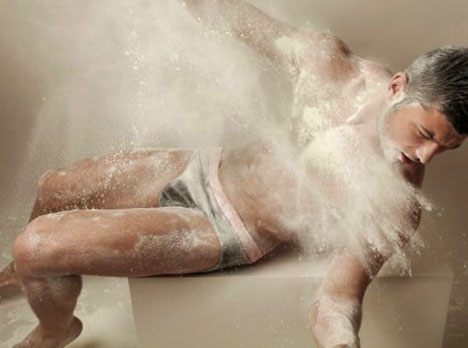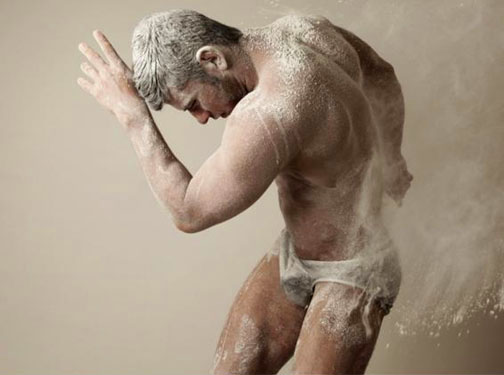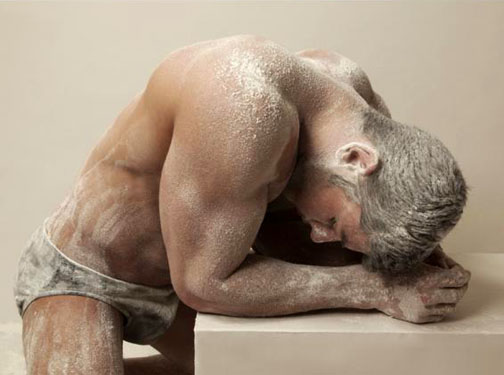The tons of gallons of water that get thrown during Songkran every year gets all the press. For those looking for fun, the holiday’s major water fights are the draw. For those who avoid having fun at all costs, those same buckets full of water provide them with plenty to bitch about. But equally reviled by fun lovers and the miserable alike is the Songkran tradition of the application of that white stuff that makes locals look like they got a face full of spunk the night before and forgot to wash it off. You may not be a fan of getting drenched, but after having your face smeared with white talcum powder you’ll be happy to have a bucketful of water dumped over your head to keep you from looking like Lindsay Lohan on a cocaine binge.
Of course since limits are ignored by Thais and those on holiday alike, some revelers have begun combining the two traditions and throw buckets full of watery white paste these days. Yuk. If you are unlucky enough to be on the receiving end of that mess, you do have the right to bitch. But then you probably deserved it anyway. Karma in Thailand tends to be fast acting.
Yesterday we looked at the origin legend of the Songkran holiday, and – possibly – where the tradition of all that water came from. If you didn’t read that post, shame on you. I’m trying to edumacate you on Thai culture here. So pay attention ‘cuz today it’s all about that white stuff. Even if your true interest lays in some other white stuff. And that should be a popular subject matter (the former rather than the latter though admittedly the latter would draw more comments) because Google says “one of the oldest Songkran traditions is where many Thai’s apply a white powder or paste to the face neck or torso of other participants”. Note that the misplaced apostrophe is Google’s fault, not mine.
You’d think being “one of the oldest Songkran traditions’ an explanation for that tradition would be not difficult to track down. But then this is Thailand. When that tradition began, why it is part of the Songkran festivities, and what, if anything, it is suppose to signify seems to be as closely guarded of a secret as that Stedman is actually Oprah’s beard. Many websites like to claim the crap is a sign of protection or is supposed to ward off evil. But then many websites also like to claim that a bird shitting on your head in Thailand is a sign of good luck. So I’m not buying it. Besides, bird shit is easier to clean off than a face full of wet talcum powder.
If you did read yesterday’s post about the Songkran legend and that damn riddle that made absolutely no sense kept you awake all night, then you may recall part of the answer was about applying perfume to the chest in the afternoon. The other two parts of the answer were about bathing your feet and face, which is supposed to be about Songkran but sounds more like a myth designed to instill good personal hygiene practices. No problemo. That feet and face washing brings water into the traditions of the holiday, and that perfume thingy brings in that damn white paste.
Traditionally, it wasn’t talcum powder or any of the other crap locals use in its place these days, but a white mud called dinsaw pong, which, outside of the Songkran celebrations is still a popular spa treatment in Thailand. So don’t think of it as one of the less pleasurable elements of Songkran, think of it as a free beauty treatment. And ignore that the traditional dinsaw pong mixture has fallen from favor since it was discovered that most of it contains very dangerous levels of lead in the pigments.
Dinsaw pong, a type of fragrant talcum not to be confused with Thanaka, another whitish paste for the face popular in Burma, has been used for many purposes in Thailand for centuries: as a beauty or medical product for clearing rashes, healing wounds, to refresh and tighten the skin, and as a skin protection from the sun as well as to protect against mosquitoes. The version used as part of the water fights during Songkran has none of those properties; it’s usually just some form of talc or any other cheap white powder party goers manage to get their hands on. Though generally not dangerous, some pastes contain menthol, which can sting if it gets in your eyes. Not that personal safety has anything to do with Songkran festivities in the first place.
Much like the tradition of drenching strangers with water began as a gentle pouring of water over elders’ hands, the current Songkran tradition of tossing a load of talc on anyone who even looks to be a bit damp started off as a more gentle and kinder rite. A small silver bowl filled with dinsaw pong was originally used to gently dab some of the paste onto the receiver’s face, neck or other part of the body. Tradition dictated that the paste should be left on until it naturally washed itself off Stemming from a practice of monks applying a similar chalk to worshipers’ faces as a blessing, many considered this custom to bring good luck. Today’s version of the practice, which went from a gentle daubing to pounds of the stuff being dumped on the unsuspecting only tends to bring good luck to those who own laundries.
Related Posts You Might Enjoy:









Hmmm….white powder and water sports! Sound like one of those mythical parties back in the 1990’s, at Steamworks!
Yeah, well, ya know the gays have always been the trend setters.
Oh, I wouldn’t mind sharing the talc and the water with your model !
And I’d love to be the one lucky enough to clean him up.